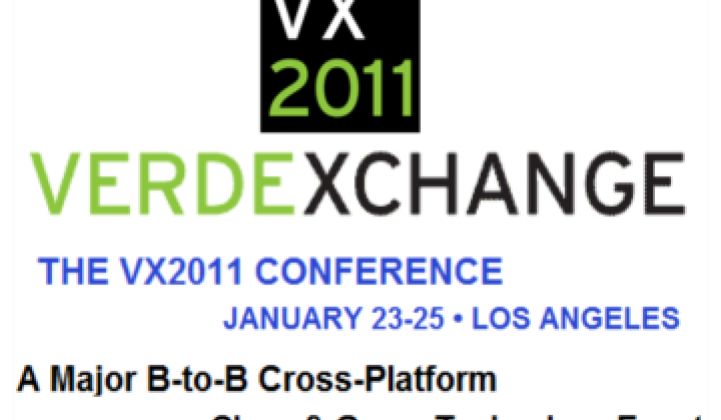By lunchtime at the fourth annual VerdeXchange, a business-to-business cross-platform Los Angeles cleantech conference, the business folks wanted to hear some moneymaking insights, the government folks were a little defensive, and the NGOs and consultants were hungry.
"This is going to be about how to make money,” greentech entrepreneur and former California Assembly Speaker Robert Hertzberg announced to the midday plenary. The subject was actually how to make money under the regulation of California’s AB 32, the most far-sighted U.S. climate change law to date, and California’s nation-leading 33%-by-2020 Renewable Portfolio Standard.
California Air Resources Board (CARB) member and Ellis Paint Company President and CEO Sandy Berg set the tone. “When my family bought Ellis Paint Company in 1964, there were about 263 manufacturers in Southern California. Today there are probably a dozen.” The secret of their success, Berg said, was that "We were able to see the opportunity in the regulation. We were able to say ‘Regulation is not going to go away. Clean air is a laudable goal.’”
“Good public policy in conjunction with clean environment,” Berg said, “absolutely equals thriving businesses.” The key, she added, is to understand the implications of new regulations, anticipate how they will change customer needs and behavior, and find the profit opportunity. “To take advantage of incentive programs, bring new technology and be a first mover,” she said.
“This is the time to look at the Renewable Energy Standard, to look at the cap and trade, at how the utilities are going to implement that” to determine “what products or services you can bring.”
There is an emerging opportunity, she pointed out, in CARB’s new small business energy and water makeover program. Small businesses will earn utility rebates for implementing efficiencies. This will create a market for entrepreneurs who can offer cost-effective efficiencies.
Hal Snyder of San Diego Gas and Electric (SDG&E) stepped up, applauded CARB, and launched into an infomercial for “clean, renewable natural gas.” He made little mention of truly emissions-free, pollution-free renewable energies. He also neglected to mention that natural gas, which California will need to burn to generate electricity during the coming decades while renewable technologies mature, is responsible for air pollution and greenhouse gas emissions. “It’s clean, it’s abundant and it’s American,” Snyder said. He concluded, like Berg, by extolling the many business opportunities in advancing energy efficiency.
Jeanne Clinton of the California Public Utilities Commission (CPUC) talked substantively about how PUC policies are guiding entrepreneurs and driving growth by sending “the clear message that we want to see investments in new technologies, we want to see new solutions, new approaches and innovation.”
The guiding principles, she said, are to meet the greenhouse gas targets for California without compromising value to ratepayers, to foster competition across technologies rather than selecting winners and to promote diversity of solutions.
“Cap and trade is twenty percent of all the strategies to achieve our greenhouse gas reductions,” Clinton said. “The other 80 percent will come from a combination of regulations, public statutes and other initiatives called complimentary policies.” What this means, she said, is that “the energy sector is a major part of the playing field.”
The opportunities where the PUC is acting as a catalyst to spark utility-business solutions, Clinton said, fall into three categories. “One is direct outsourcing. Secondly, businesses are having what I call reach-out transactions with end-users with those transactions bolstered or supported by the utility financial incentives. And third, and perhaps most important, the potential for new opportunities and new partnerships.”
The PUC has directly outsourced, Clinton said, 20,000 megawatts of renewable energy development, representing 40 percent of Califonia’s 50,000-megawatt peak demand. The newly approved Reverse Auction Mechanism, a modified feed-in tariff for small renewables developers, is, she added, another direct outsourcing policy.
The $2.5 billion California Solar Initiative (CSI) and the Self Generation Incentive Program (SGIP) and the state’s deployment of ten million smart meters are all successful reach-out policies, Clinton noted.
The PUC is driving innovation through investment of ratepayer money in research and development. “We’re trying to foster new technologies, new business solutions, new ways to integrate into the grid so that we can get more solar installed at a lower cost.”
PUC also “has $60 million dollars on the energy efficiency side for what we call the Emerging Technologies Program,” Clinton said, with the goal to provide funding that will move the best ideas quickly from early adoption to commercialization. It is also the state for the rollout of electric vehicles and “to make charging your car cheaper and easier than going to the gas station.”
Southern California Edison (SCE) Director of Energy Efficiency Gene Rodriques concluded the program. Rodriques characterized current California policy as designed in an open and transparent process “to address the rebuilding of the American economy, to address the moral imperative of greenhouse gas reduction” and “to provide safe, reliable, reasonably priced energy.”
Echoing moderator Hertzberg’s opening promise that the session would be about how to make money, Rodriques closed by saying, “If you have a solution, if you offer either a product or a service that could be part of the new, strong and green economy,” utilities are driven by California policy to look for those “new, smarter, cleaner ways.”
If you don’t seize the opportunity, Rodriques added, “the person across the table from you will eat your lunch.”



